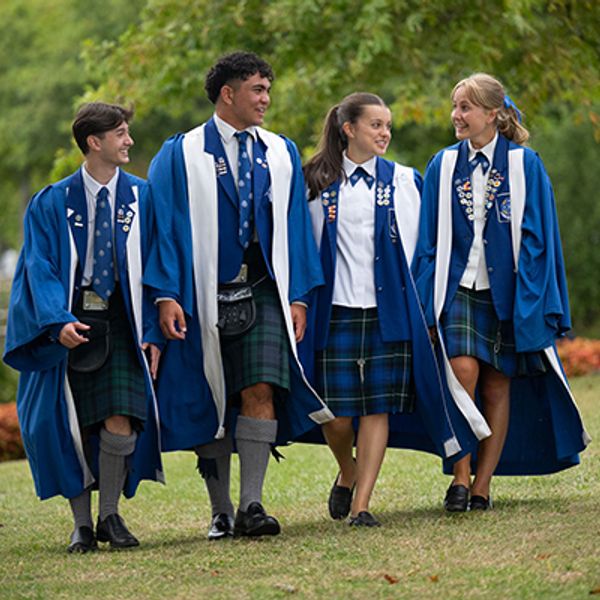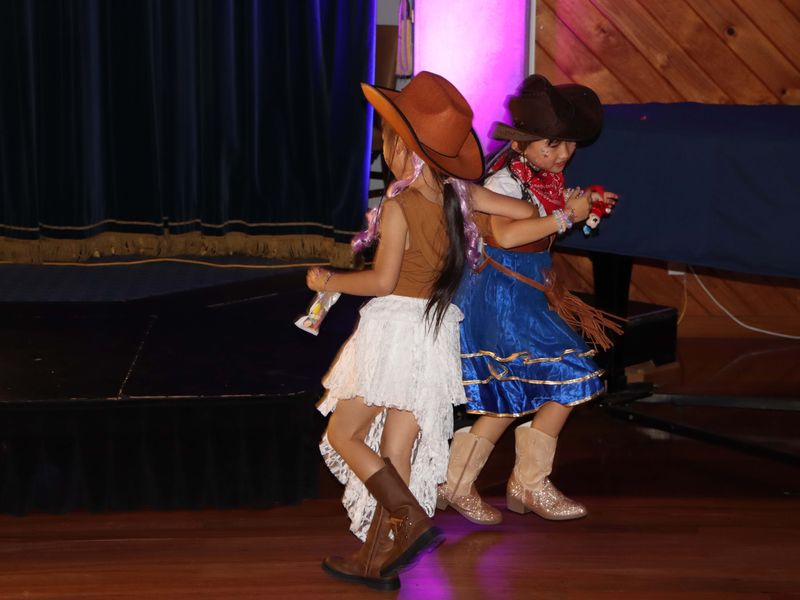
Saint Kentigern Banner Unveiled
Saint Kentigern Banner Unveiled
February 09, 2018 at 2:17 PM
‘This is the bird that never flew
This is the tree that never grew
This is the bell that never rang
This is the fish that never swam’
Over the course of 2017, as part of a combined Christian Education and Visual Arts project, the students in Years 4-7 at the Girls’ School worked on a ‘Miracles of Saint Kentigern’ banner, similar in style to those produced in the past for Christmas, Easter and the changing seasons. After many weeks of designing, sketching, painting and applying dyes, the girls completed their artwork prior to Christmas, ready to pass their artwork on for the sewing and quilting process.
Working in small groups within their year level, the girls were each responsible for a section of the banner. Each panel depictS one of the four miracles that Saint Kentigern performed during his life.
The Year 4 students were tasked with working on the ‘fish’ which symbolises the one caught by Kentigern in the Clyde. When it was slit open, a ring belonging to the Queen of Cadzow was miraculously found inside it, clearing her name of infidelity.
The Year 5 students took care of the ‘tree’ which is a symbol of another incident in Saint Kentigern’s childhood. Left in charge of the holy fire in St Serf’s monastery, he fell asleep and the fire went out. However, he broke off some frozen branches from a hazel tree and miraculously rekindled the fire.
The Year 6 students designed the ‘bell’ which is thought to have been brought by Saint Kentigern from Rome. The original bell, which was rung at funerals, no longer exists and was replaced by the magistrates of Glasgow in 1641. The bell of 1641 is preserved in the People’s Palace in Glasgow.
The Year 7 students were responsible for the ‘bird’, which commemorates the pet robin owned by St Serf, which was accidentally killed by monks who blamed it on Saint Kentigern. He took the bird in his hands and prayed over it, restoring it to life again.
When the designs of each miracle were completed, they were transferred onto calico for the girls to work on, each having a part to play. They applied fabric dye and used permanent markers to add the detail. Art Specialist, Mrs Diana Roband, passed the girls’ completed panels onto her sister, Linda McAdams who kindly took on the quilting to complete the process.
The banner was presented this week at the Girls’ School Chapel in Sommervell Church. There was an audible gasp as the work was unveiled, a beautiful addition to the set of hanging banners in the school hall. Well done girls and our sincere thanks to Mrs McAdams for taking the time to complete this fantastic piece of work.
THE STORY OF SAINT KENTIGERN
Our early saints were extraordinary men. They believed in an unknown God and by spreading his word changed history. Saint Kentigern was such a man.
Kentigern was born near Edinburgh, Scotland in the sixth century. His mother, St Enoch, was daughter of the King of Lothian. Her pregnancy was illegitimate, the result of assault by one of her suitors, whose identity she refused to reveal. Her father was so incensed, he had Enoch and her child cast adrift in an open boat on the Firth of Forth, expecting them to perish. The currents carried them across to the other side of the Firth, bringing them to land near the present town of Culross where they were offered shelter at the monastery of St Serf.
Serf took the boy under his special care, educating him and training him in the monastic life. When he reached manhood Kentigern left the monastery and journeyed across to the west of Scotland, finally establishing his own religious foundation on the site of the cathedral in Glasgow. Here he set about converting the area to Christianity. At a later stage he journeyed south into England and many parishes along his route still bear his name. Legend has it that he finally reached North Wales and spent several years there before returning again to Scotland, where he died c. 603.
From the time of his death Saint Kentigern was venerated as Glasgow’s patron saint, and the cathedral of Glasgow was built in his honour. To this day his figure and the symbols associated with his legend make up the crest of the City of Glasgow.
The attributes of Saint Kentigern, more popularly known by his pet name Mungo, are remembered in a nonsense rhyme taught to Glasgow school children about the city’s Coat of Arms:
‘This is the bird that never flew
This is the tree that never grew
This is the bell that never rang
This is the fish that never swam’
The Bird commemorates the pet robin owned by St Serf, which was accidentally killed by monks but who blamed it on Kentigern. Kentigern took the bird in his hands and prayed over it, restoring it to life again.
The Tree is the symbol of another incident in Kentigern’s childhood. Left in charge of the holy fire in St Serf’s monastery, he fell asleep and the fire went out. However, he broke off some frozen branches from a hazel tree and miraculously rekindled the fire.
The Bell may have been given to Kentigern by the Pope. The original bell, which was tolled at funerals, no longer exists and was replaced by the magistrates of Glasgow in 1641. The bell of 1641 is preserved in the People’s Palace.
The Fish was one caught by Kentigern in the Clyde. When it was slit open, a Ring belonging to the Queen of Cadzow was miraculously found inside it. The Queen was suspected of intrigue by her husband, as she had parted with his ring. She implored Kentigern for help, and he found and restored the ring to her in this way.









